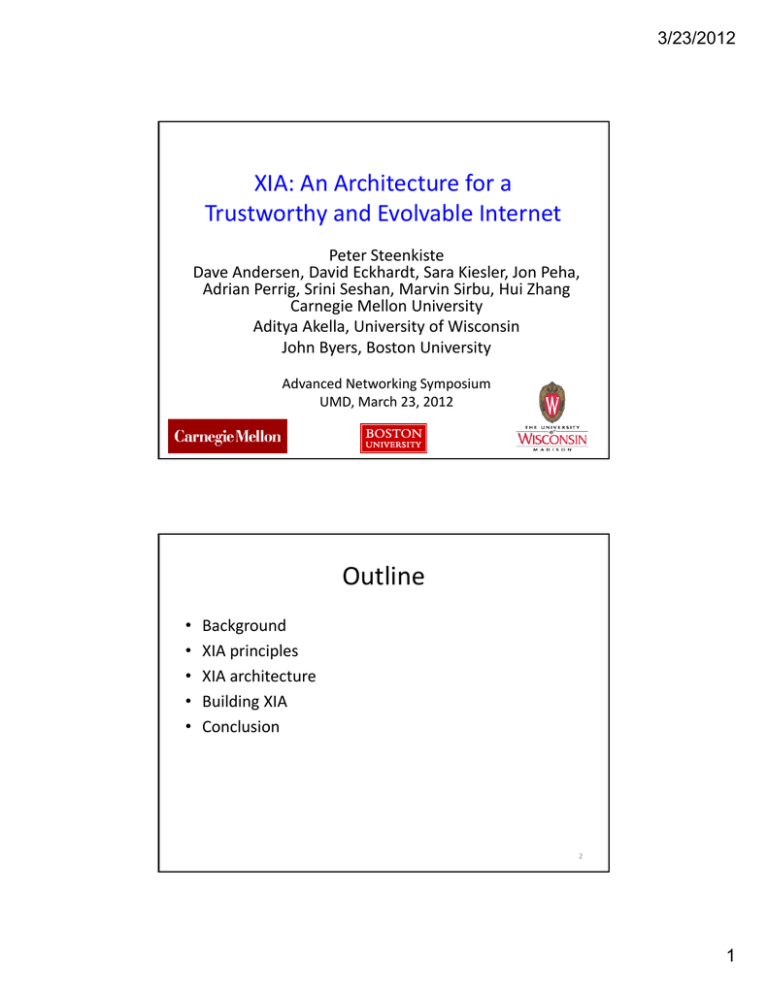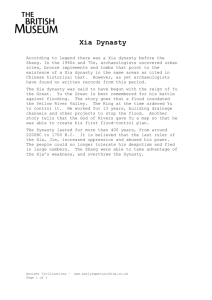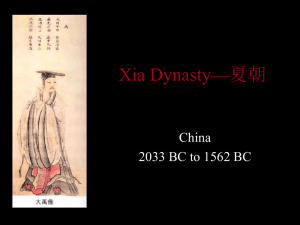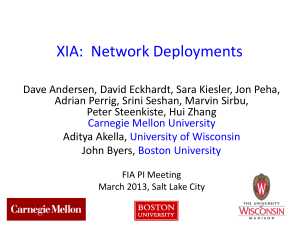XIA: An Architecture for a Trustworthy and Evolvable Internet
advertisement

3/23/2012 XIA: An Architecture for a Trustworthy and Evolvable Internet Peter Steenkiste Dave Andersen, David Eckhardt, Sara Kiesler, Jon Peha, Adrian Perrig, Srini Seshan, Marvin Sirbu, Hui Zhang Carnegie Mellon University Aditya Akella, University of Wisconsin John Byers Boston University John Byers, Boston University Advanced Networking Symposium UMD, March 23, 2012 1 Outline • • • • • Background XIA i i l XIA principles XIA architecture Building XIA Conclusion 2 1 3/23/2012 NSF Future Internet Architecture • Fundamental changes to the Internet architecture – Avoid constraints imposed by current Internet p y – Long‐term, multi‐phase effort • Four teams were selected in the second phase: – Named Internet Architecture: content centric networking ‐ data is a (the) first class entity – Mobility First: mobility as the norm rather than the exception – generalizes delay tolerant networking – Nebula: Internet centered around cloud computing data centers that are well connected – eXpressive Internet Architecture: focus on trustworthiness, evolvability 3 XIA Vision We envision a future Internet that: • Is trustworthy – Security broadly defined is the biggest challenge • Supports long‐term evolution of usage models – Including host‐host, content retrieval, services, … • Supports long term technology evolution – Not just for link technologies, but also for storage and computing capabilities in the network and end points computing capabilities in the network and end‐points • Allows all actors to operate effectively – Despite differences in roles, goals and incentives 4 2 3/23/2012 Predicting the Future is Hard! – A lot of really smart people don’t agree: – Named Named Data Networking: content centric networking Data Networking: content centric networking ‐ data is a first class entity – Mobility First: mobility as the norm rather than the exception – generalizes delay tolerant networking – Nebula: Internet centered around cloud computing data centers that are well connected data centers that are well connected We love all of them! 5 Today’s Internet Src: Client IP Dest: Server IP TCP Client IP Server IP • Client retrieves document from a specific web server – But client mostly cares about correctness of content, timeliness But client mostly cares about correctness of content timeliness – Specific server, file name, etc. are not of interest • Transfer is between wrong principals – What if the server fails? – Optimizing transfer using local caches is hard • Need to use application‐specific overlay or transparent proxy – bad! 6 3 3/23/2012 eXpressive Internet Architecture Src: Client ID Dest: Content ID PDA Content • Client expresses communication intent for content explicitly – Network Network uses content identifier to retrieve content from appropriate uses content identifier to retrieve content from appropriate location • How does client know the content is correct? – Intrinsic security! Verify content using self‐certifying id: hash(content) = content id • How does source know it is talking to the right client? – Intrinsic security! Self‐certifying host identifiers 7 A Bit More Detail … Dest: Service ID Content Name? Dest: Client ID Content ID Flexible Trust Management Diverse Communicating Entities Dest: Content ID Anywhere Intrinsic Security Hash( ) = CID? 8 4 3/23/2012 Evolvable Set of Principals • Identifying the intended communicating entities reduces complexity and overhead entities reduces complexity and overhead – No need to force all communication at a lower level (hosts), as in today’s Internet • Allows the network to evolve Content a581fe9 ... Services d9389fa … Host 024e881 … Future Entities 39c0348 … 9 Security as Intrinsic as Possible • Security properties are a direct result of the g y design of the system – Do not rely on correctness of external configurations, actions, data bases – Malicious actions can be easily identified Content a581fe9 ... Services d9389fa … Host 024e881 … Future Entities 39c0348 … 10 5 3/23/2012 Other XIA Principles • Narrow waist for all principals – Defines the API between the principals and the network protocol mechanisms t l h i • Narrow waist for trust management – Ensure that the inputs to the intrinsically secure system match the trust assumptions and intensions of the user – Narrow waist allows leveraging diverse mechanisms for trust management: CAs, reputation, personal, … trust management: CAs, reputation, personal, … • All other network functions are explicit services – Keeps the architecture simple and easy to reason about – XIA provides a principal type for services (visible) Look familiar? 11 XIA: eXpressive Internet Architecture • Each communication operation expresses the intent of the operation intent of the operation – Also: explicit trust management, APIs among actors • XIA is a single inter‐network in which all principals are connected – Not a collection of architectures implemented Not a collection of architectures implemented through, e.g., virtualization or overlays – Not based on a “preferred” principal (host or content), that has to support all communication 12 6 3/23/2012 What Applications Does XIA Support? • Since XIA supports host‐based communication, today’ss applications continue to work today applications continue to work – Will benefit from the intrinsic security properties • New applications can express the right principal – – – – – Can also specify other principals (host based) as fallbacks Content‐centric applications Explicit reliance on network services Explicit reliance on network services Mobile users As yet unknown usage models 13 Users Applications Services Host Support Content Support Services Support eXpressive Internet Protocol Intrinsic y Security … Trustworrthy Network Operation Network‐‐Network User‐Network XIA Components and Interactions 14 7 3/23/2012 How about the Real World? User trust Trust Management Users Transparency Control Privacy Incentives Provider Relationships Network Operations Policy and Economics Forwarding Trust Policy Verifiable Actions Core Network Control Points 15 Outline • Background • XIA principles XIA i i l • XIA architecture – Multiple principals – DAG‐based addressing – Intrinsic securityy • Building XIA • Conclusion 16 8 3/23/2012 Developing XIA v0.1 • Principles do not make an architecture! Meet the core XIA team: • Meet the core XIA team: Fahad Dogar Five happy professors cheering: John Byers, Aditya Akella, Dave Anderson, Srini Seshan, Peter Steenkiste Dongsu Hyeontaek Ashok Han Lim Anand Michel Machadoy Boyan Li Wenfei Wu • Next: quick look at multiple principals, fallbacks and DAGs, intrinsic security 17 What Do We Mean by Evolvability? • Narrow waist of the Internet has allowed the network to evolve significantly network to evolve significantly • But need to evolve the waist as well! – Can make the waist smarter XIA adds evolvability at the waist: IP: Evolvability of: Applications Link technologies Applications Evolving set of principals Link technologies 18 9 3/23/2012 Multiple Principal Types • Hosts XIDs support host‐based communication similar to IP – who? • Service XIDs allow the network to route to possibly replicated services – what does it do? – LAN services access, WAN replication, … • Content XIDs allow network to retrieve content from “anywhere” – what is it? – Opportunistic caches, CDNs, … • Autonomous domains allow scoping, hierarchy • What are conditions for adding principal types? 19 Multiple Principal Types Choice involves tradeoffs: • Control • Trust • Efficiencyy • Privacyy Service SID Host HID SID CID Content CID Content CID Content CID Content CID Service SID CID Content CID Content CID Content CID 20 10 3/23/2012 Supporting Evolvability • Introduction of a new principal type will be incremental – no “flag day”! – Not all routers and ISPs will provide support from day one • Creates chicken and egg problem ‐ what comes first: network support or use in applications • Solution is to provide an …. intent and fallback address CID – Intent address allows in‐ dd ll network optimizations based on user intent – Fallback address is guaranteed to be reachable Dest AD:HID AD:HID Src …. Payload 21 Addressing Requirements • Fallback: intent that may not be globally understood must include a backwards compatible address must include a backwards compatible address – Incremental introduction of new XID types • Scoping: support reachability for non‐globally routable XID types or XIDs – Needed for scalability – Generalize scoping based on network identifiers Generalize scoping based on network identifiers – But we do not want to give up leveraging intent • Iterative refinement: give each XID in the hierarchy option of using intent 22 11 3/23/2012 Our Solution: DAG‐Based Addressing • Uses direct acyclic graph (DAG) – Nodes: typed IDs (XID; expressive identifier) N d t d ID (XID i id tifi ) – Outgoing edges: possible routing choices • Simple example: Sending a packet to HIDS HIDS Dummy source: special node indicating packet sender Intent: final destination of packet with no outgoing edges 23 Support for Fallbacks with DAG • A node can have multiple outgoing edges Primary edges Fallback edge (low priority edge) HIDS CIDA Intermediate node • Outgoing edges have priority among them – Forwarding to HIDS is attempted if forwarding to CIDA is not possible – Realization of fallbacks 24 12 3/23/2012 Support for Scoping with DAG Server‐side domain hierarchy Client side AD0 HIDS AD1 Support scalable routing, binding, migration, mobility, …25 Iterative Refinement: Scoping while Maintaining Intent Client side Server‐side domain hierarchy CIDS AD0 HIDS AD1 26 13 3/23/2012 DAG Addressing Research Questions • DAG addressing supports is flexible … – Fallback, binding, source routing, mobility, .. llb k b d bl • … but many questions remain: – Is it expensive to process? – How big will the addresses be? – How do ISPs verify policy compliance? How do ISPs verify policy compliance? – Can they be used to attack network? – Can it be deployed incrementally? 27 Intrinsic Security in XIA • XIA uses self‐certifying identifiers that guarantee security properties for communication operation yp p p – Host ID is a hash of its public key – accountability (AIP) – Content ID is a hash of the content – correctness – Does not rely on external configurations • Intrinsic security is specific to the principal type Example: retrieve content using … • Example: retrieve content using … – Content XID: content is correct – Service XID: the right service provided content – Host XID: content was delivered from right host 28 14 3/23/2012 Example of Secure Mobile Service Access Server S2: Register “bof.com” HIDS2 -> ADBOF:SIDBOF SIDBoF X ADBoF SIDBOF S 2 ADBoF:HIDS:SIDBoF ADC:HIDC:SIDC ADBoF:HIDS2:SIDBoF ADC:HIDC:SIDC ADBoF:HIDS2:SIDBoF ADC2:HIDC:SIDC Server S: HIDS SIDBoF ADBoF:SIDBoF XIA Internet SIDResolv ADC ADC2 Client C: HIDC SIDC Client C: HIDC SIDC bof.com ADBOF:SIDBOF Name Resolution Service 29 Outline Background XIA i i l XIA principles XIA architecture Building XIA – Forwarding packets – Building a network g – Prototype • Conclusion • • • • 30 15 3/23/2012 Putting Address into Packet Headers Graphic view Per‐node view Node 1 Node ‐1 CIDA Node 0 HIDS Node 0 HIDS Node 1 CIDA Node 1 31 XIP Packet Header • DAGs represent source and destination addresses • Array of nodes with pointers • Maintains a LastNode field in the header – Routers to know where to begin forwarding lookups Version=XIP1.0 Next Header Payload length Hop Limit #Destination nodes #Source nodes Last node = AD1 Destinati on nodess XID type 160 Bit ID Edge0 Edge1 Edge2 Edge3 … Source nodes XID type 160 Bit ID Edge 0 Edge 1 Edge 2 Edge 3 …. 16 3/23/2012 Router’s View on Packet Forwarding SIDS ADS Last visited node HIDS (In packet header) 1. Forward to SIDS if possible 2. Otherwise, forward to ADS • If router is ADS itself, update last visited node to ADS 33 XIP Forwarding 1. Find a routable edge from last visited node and select one with highest priority 2. If the next node refers to itself 1. 2. 3. Advance last visited node pointer If there is no outgoing edge, the packet has arrived at the destination; send it to upper layer (transport) Otherwise, go to step 1 3. Otherwise, try to forward to next hop 1. Forward if forwarding information is available g 2. Otherwise move to next node in the list • No per‐packet state in routers – high‐speed forwarding 34 17 3/23/2012 Packet Processing Pipeline AD AD Input Source XID Type Classifier HID SID CID Next‐Dest XID Type Classifier HID SID Route Success ? Output CID • Principle‐independent processing defines how to interpret the DAG The core XIA architecture • The core XIA architecture • Principle‐dependent processing realizes forwarding semantics for each XID type • Optimizations possible: fast path processing, packet level and intra‐packet parallelism 35 Evaluation Setup • Router • Packet generator Software: PacketShader I/O Engine Click modular router – multithreaded(12 threads) H d Hardware: 10Gbit NIC : 4 ports (multi‐queue support) 2x 6 Core Intel Xeon @ 2.26GHz 18 3/23/2012 CPU Time for Processing With increase in number of fallbacks, the look up time increases. Forwarding Performance Comparison 351K FIB entries Workload Identifiers generated using Workload: sing Pareto distribution XIP forwarding is fast! @128 byte FB0 is 8% slower than IP @192 byte FB3 is 26% slower than IP 19 3/23/2012 Fast Path Performance 8% drop 20% drop Look-aside cache of 1024 entries Using fast-path processing, the gap between FB0 and FB3 is reduced significantly ! Summary • XIA packet forwarding cost is reasonably competitive compared with IP! titi d ith IP! • Inter‐packet parallelism and fast‐path can be applied to get high‐speed XIA forwarding on software routers • Intra‐packet parallelism can be used for further Intra‐packet parallelism can be used for further speedup in hardware implementations 20 3/23/2012 Outline Background XIA i i l XIA principles XIA architecture Building XIA – Forwarding packets – Building a network g – Prototype • Conclusion • • • • 41 XIP Protocol Stack Routing XHCP BIND Applications Chunking Xsockets XDP XChunkP XSP ARP XIP Cache XCMP Datalink 42 21 3/23/2012 Prototype Platform • Click‐based prototype in progress – Full stack for routers, caches, and end Full stack for routers, caches, and end‐points points – Barebones transport, routing, ... • Ongoing research in these areas – User‐level/in‐kernel, native/overlay • Initial release expected end of January – Focus on GENI based experiments – Broaden set of developers • Extend over time by integrating research 43 Users Applications Services Host Support Content Support Services Support eXpressive Internet Protocol Intrinsic y Security … Trustworrthy Network Operation Network‐‐Network User‐Network XIA Components and Interactions 44 22 3/23/2012 Some Ongoing Research Activities • Transport protocols – Multiple principals, content, congestion control, .. Multiple principals content congestion control • Deployment of services and applications – Use of principal types, intrinsic security, … • Network operations – Alternative routing strategies, e.g. Scion g g , g – Definition of DAGs, naming, diagnostics, … • Evaluation and refinement of architecture • User studies, policy/economics collaboration 45 Conclusion • XIA supports evolution, expressiveness, and trustworthy operation trustworthy operation. – Multiple principal types, flexible addressing, and intrinsic security • But research has just started! – Transport protocols, applications, services, … – Trustworthy protocols that fully utilizes intrinsic security of XIA • More information on http://www.cs.cmu.edu/~xia 46 23







